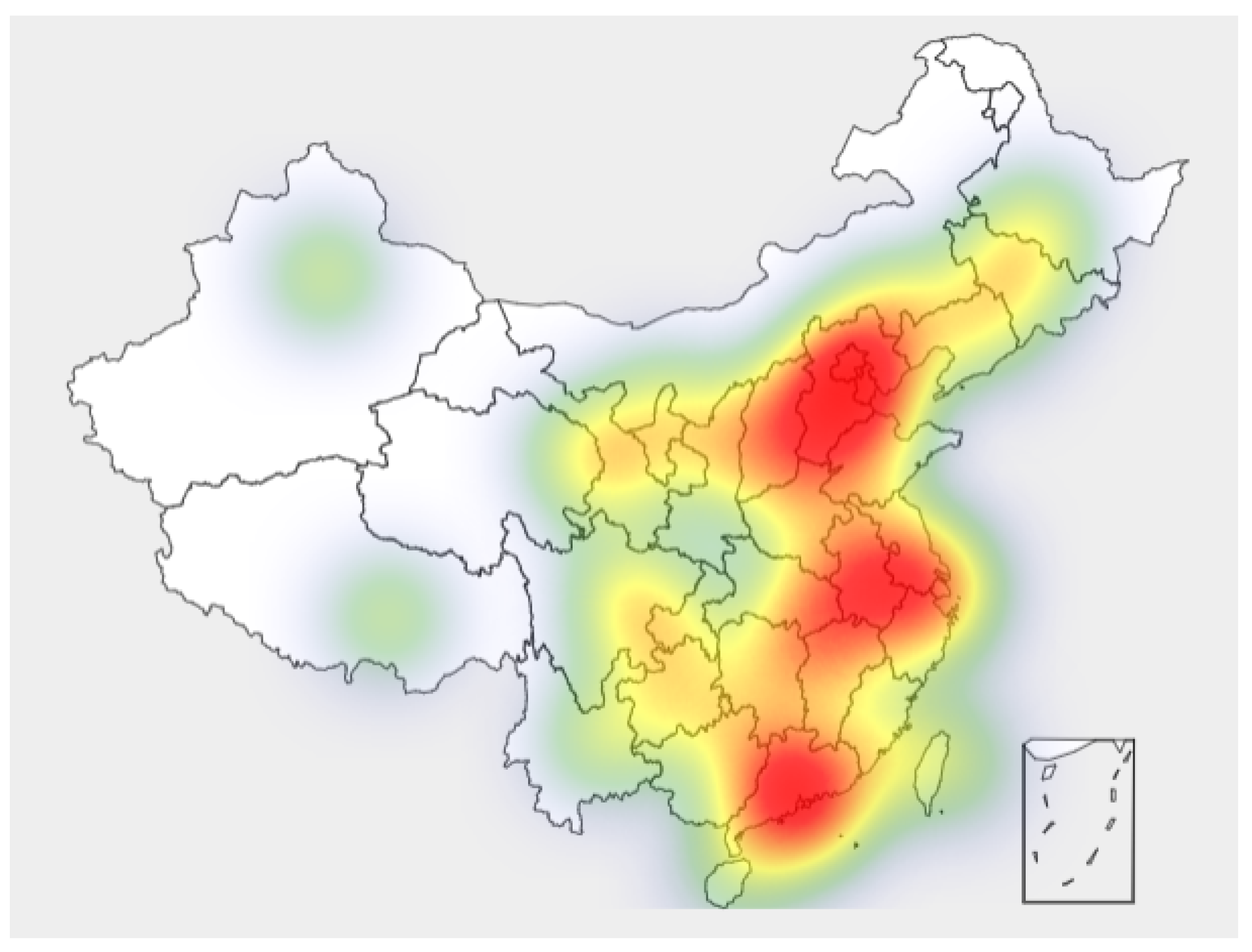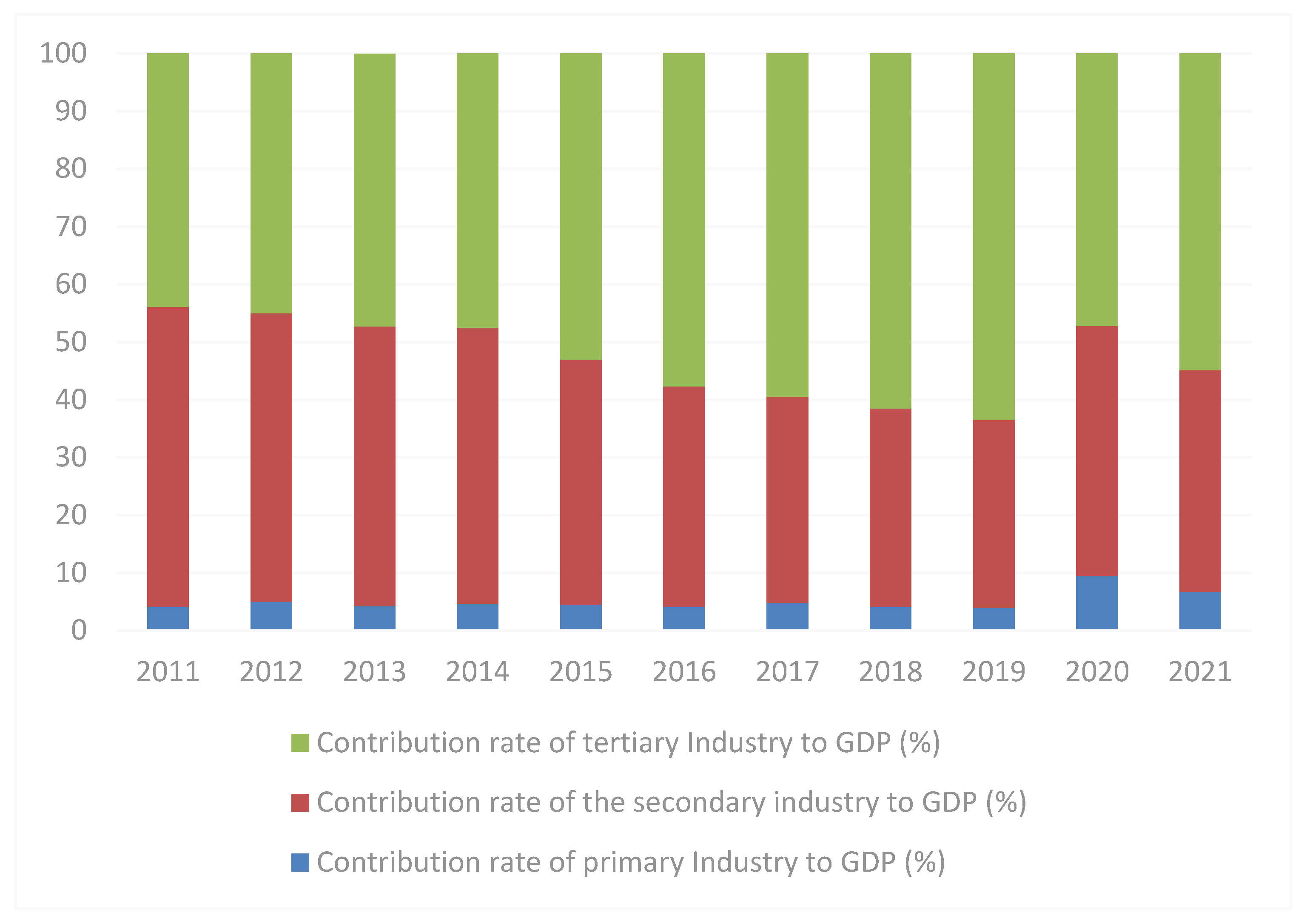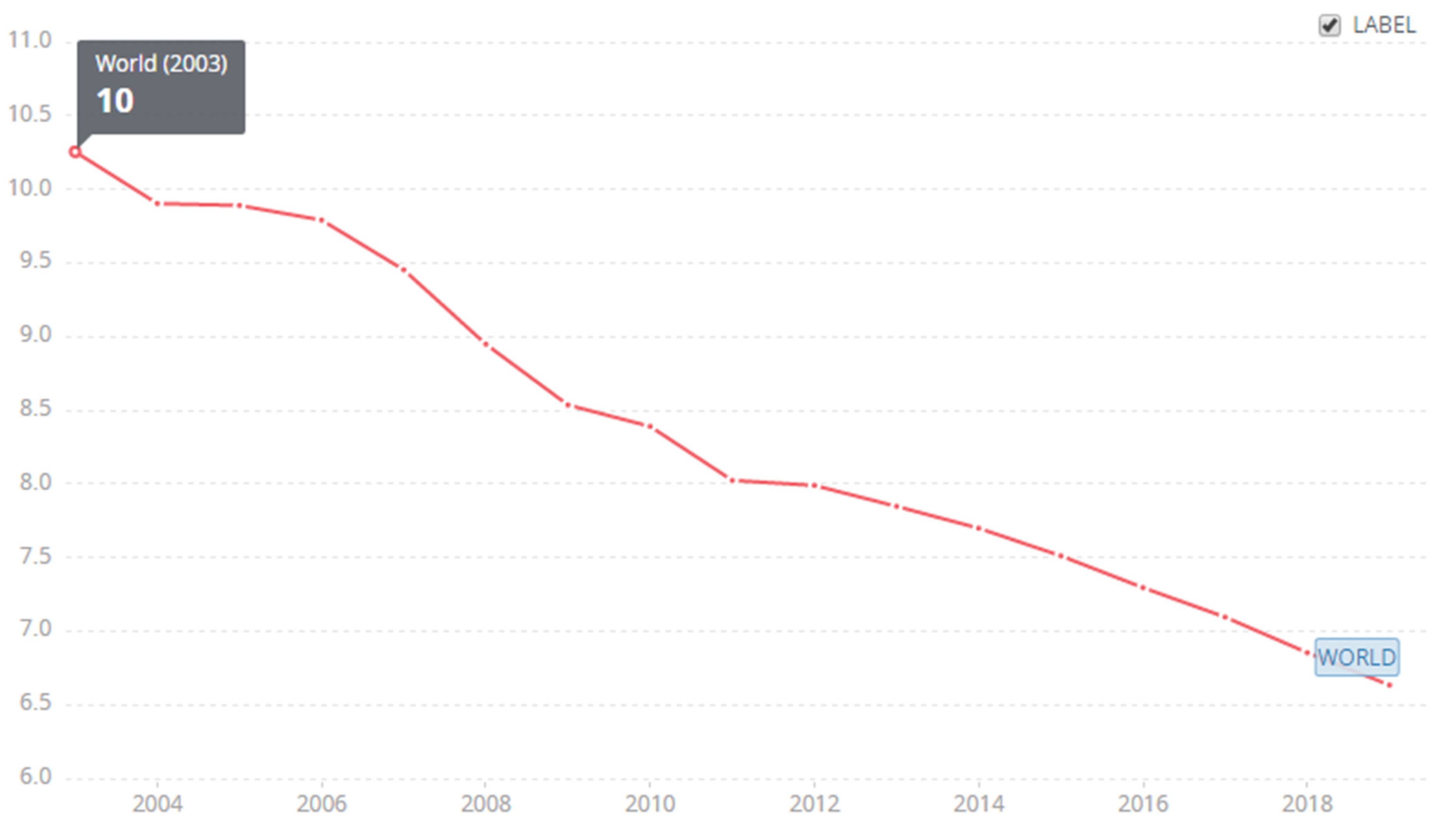Facing the COVID-19 Pandemic and Developing a Sustainable Entrepreneurial Ecosystem: The Theory and Practice of Innovation and Entrepreneurship Policies in China
Abstract
:1. Introduction
2. Concepts Related to Innovation and Entrepreneurship Policies
2.1. Connotation and Metric
2.1.1. Connotation of Innovation and Entrepreneurship
2.1.2. Measures of Innovation and Entrepreneurship Policies
- Supply-type policy instruments
- 2.
- Environmental-type policy instruments
- 3.
- Demand-based policy instruments
2.1.3. Theoretical Review
2.2. Formation and Development
2.2.1. Formation of Innovation and Entrepreneurship Policies
2.2.2. Innovation and Entrepreneurship Policy Development
- Entrepreneurship policy for overseas returnees
- 2.
- Entrepreneurship policy for college students
3. Mechanism of Action and Evaluation Method of Innovation and Entrepreneurship Policies
3.1. Mechanism of Action
3.1.1. Impact of Policies on the Formation of New Enterprises
3.1.2. Impact of Innovation and Entrepreneurship Policies on Entrepreneurial Output
3.2. Evaluation Method
3.2.1. Evaluation of the Formulation of Innovation and Entrepreneurship Policies
3.2.2. Evaluation of the Effects of the Implementation of Innovation and Entrepreneurship Policies
4. Development Status of China’s Innovation and Entrepreneurship Policies
4.1. The Context behind Landmark Policy Development
4.2. Regional Policy Concerns
4.3. Effect of Innovation and Entrepreneurship Policies
4.4. Policy Outputs around COVID-19
4.5. Looking for International
5. Future Research
5.1. Exploring the Action Mechanism of Demand-Based Policy Instruments with the Market as the Main Body
5.2. Exploring the Relevant Research on the Mechanism of Government Action Based on Financial Support
5.3. Exploring the Important Impact of the Supervision of New Industries, New Models and New Forms of Business on the Development of Enterprises
5.4. Focus on Building a Sustainable Entrepreneurial Ecosystem
6. Conclusions
Author Contributions
Funding
Institutional Review Board Statement
Informed Consent Statement
Conflicts of Interest
References
- Rastoka, J.; Petković, S.; Radicic, D. Impact of Entrepreneurship on the Quality of Public Health Sector Institutions and Poli-cies. Int. J. Environ. Res. Public Health 2022, 19, 1569. [Google Scholar] [CrossRef] [PubMed]
- Jetzek, T.; Avital, M.; Bjorn-Andersen, N. Data-driven innovation through open government data. J. Theor. Appl. Electron. Commer. Res. 2014, 9, 100–120. [Google Scholar]
- Sussan, F.; Acs, Z.J. The digital entrepreneurial ecosystem. Small Bus. Econ. 2017, 49, 55–73. [Google Scholar] [CrossRef]
- Innovations in Government: Research, Recognition, and Replication; Borins, S.F. (Ed.) Brookings Institution Press: Washington, DC, USA, 2009. [Google Scholar]
- Galindo-Martín, M.A.; Castaño-Martínez, M.S.; Méndez-Picazo, M.T. The relationship between green innovation, social entre-preneurship, and sustainable development. Sustainability 2020, 12, 4467. [Google Scholar] [CrossRef]
- Su, C.W.; Xie, Y.; Shahab, S.; Faisal, C.M.N.; Hafeez, M.; Qamri, G.M. Towards achieving sustainable development: Role of technology innovation, technology adoption and CO2 emission for BRICS. Int. J. Environ. Res. Public Health 2021, 18, 277. [Google Scholar] [CrossRef] [PubMed]
- Kang, Y.; Xiong, W. Is entrepreneurship a remedy for Chinese university graduates’ unemployment under the massification of higher education? A case study of young entrepreneurs in Shenzhen. Int. J. Educ. Dev. 2021, 84, 102406. [Google Scholar] [CrossRef]
- Wennekers, S.; Thurik, R. Linking Entrepreneurship and Economic Growth. Small Bus. Econ. 1999, 13, 27–56. [Google Scholar] [CrossRef]
- Yi, M.; Fang, X.; Wen, L.; Guang, F.; Zhang, Y. The Heterogeneous Effects of Different Environmental Policy Instruments on Green Technology Innovation. Int. J. Environ. Res. Public Health 2019, 16, 4660. [Google Scholar] [CrossRef] [Green Version]
- Chu, Y.; Shen, S. Adoption of Major Housing Adaptation Policy Innovation for Older Adults by Provincial Governments in China: The Case of Existing Multifamily Dwelling Elevator Retrofit Projects. Int. J. Environ. Res. Public Health 2022, 19, 6124. [Google Scholar] [CrossRef] [PubMed]
- Zhu, Y.; Sun, Z.; Zhang, S.; Wang, X. Economic Policy Uncertainty, Environmental Regulation, and Green Innovation —An Empiri-cal Study Based on Chinese High-Tech Enterprises. Int. J. Environ. Res. Public Health 2021, 18, 9503. [Google Scholar] [CrossRef]
- Rothwell, R.O.Y.; Zegveld, W. An Assessment of Government Innovation Policies. In Government Innovation Policy; Palgrave Macmillan: London, UK, 1988; pp. 19–35. [Google Scholar]
- Hood, C. Instruments of Government; Macmillan International Higher Education: London, UK, 1983. [Google Scholar]
- Howlett, M. Do networks matter? Linking policy network structure to policy outcomes: Evidence from four Canadian policy sectors 1990–2000. Can. J. Political Sci. 2002, 35, 235–267. [Google Scholar] [CrossRef]
- Bemelmans-Videc, M.L.; Rist, R.C.; Vedung, E.; Evert, V.; van der Doelen Frans, C.J. The sermon: Information programs in the public policy process —choice, effects, and evaluation. In Carrots, Sticks & Sermons; Routledge: London, UK, 2017; pp. 103–128. [Google Scholar]
- Mokitimi, S.; Schneider, M.; De Vries, P.J. Child and adolescent mental health policy in South Africa: History, current policy development and implementation, and policy analysis. Int. J. Ment. Health Syst. 2018, 12, 36. [Google Scholar] [CrossRef] [PubMed]
- Gilbert, B.A.; Audretsch, D.B.; McDougall, P.P. The emergence of entrepreneurship policy. Small Bus. Econ. 2004, 22, 313–323. [Google Scholar] [CrossRef]
- Carrillo, F.J. Capital systems: Implications for a global knowledge agenda. J. Knowl. Manag. 2002, 6, 379–399. [Google Scholar] [CrossRef] [Green Version]
- Gifford, E.; McKelvey, M. Knowledge-Intensive Entrepreneurship and S3: Conceptualizing Strategies for Sustainability. Sustainability 2019, 11, 4824. [Google Scholar] [CrossRef] [Green Version]
- Chengwei, G. Policy analysis for introducing overseas technology professionals in the new era of China. Sci. Res. Manag. 2015, 36, 272–278. [Google Scholar]
- Wen, P.; Yunlong, D. Policy principles for the creation and success of university spin-off companies. Sci. Res. Manag. 2014, 35, 171. [Google Scholar]
- Yanjun, Y.; Lijun, Z. Optimization of enterprising policies environment for university graduates in Beijing. Sci. Res. Manag. 2016, 37, 463–467. [Google Scholar]
- Shane, S.; Nicolaou, N. Creative personality, opportunity recognition and the tendency to start businesses: A study of their genetic predispositions. J. Bus. Ventur. 2015, 30, 407–419. [Google Scholar] [CrossRef]
- Rossano, S.; Meerman, A.; Kesting, T.; Baaken, T. The Relevance of Problem-based Learning for Policy Development in University-Business Cooperation. Eur. J. Educ. 2016, 51, 40–55. [Google Scholar] [CrossRef]
- Audretsch, D.B. Entrepreneurship, economic growth, and geography. Oxf. Rev. Econ. Policy 2018, 34, 637–651. [Google Scholar] [CrossRef]
- Redmond, W.H. Innovation, diffusion, and institutional change. J. Econ. Issues 2003, 37, 665–679. [Google Scholar] [CrossRef]
- Audretsch, D.B.; Heger, D.; Veith, T. Infrastructure and entrepreneurship. Small Bus. Econ. 2015, 44, 219–230. [Google Scholar] [CrossRef]
- Bardzell, S.; Bardzell, J.; Ng, S. Supporting cultures of making: Technology, policy, visions, and myths. In Proceedings of the 2017 CHI Conference on Human Factors in Computing Systems, Denver, CO, USA, 6–11 May 2017; pp. 6523–6535. [Google Scholar]
- Baradwaj, B.G.; Dewally, M.; Shao, Y. Does securitization support entrepreneurial activity? J. Financ. Serv. Res. 2015, 47, 1–25. [Google Scholar] [CrossRef]
- Fang, L.; Lerner, J.; Wu, C.; Zhang, Q. Corruption, Government Subsidies, and Innovation: Evidence from China; National Bureau of Economic Research: Cambridge, MA, USA, 2018. [Google Scholar]
- Gompers, P.; Lerner, J. The Use of Covenants: An Empirical Analysis of Venture Partnership Agreements. J. Law Econ. 1996, 39, 463–498. [Google Scholar] [CrossRef]
- Gompers, P.A.; Lerner, J.; Blair, M.M.; Hellmann, T. What Drives Venture Capital Fundraising? Brook. Pap. Econ. Act. Microecon. 1998, 1998, 149. [Google Scholar] [CrossRef]
- Yu, C.; Jingjing, C. Evaluation of the conduction effect of incubator tax incentive. Sci. Res. Manag. 2016, 37, 101. [Google Scholar]
- Phulkerd, S.; Rachmi, C.N.; Sameeha, M.J.; Borazon, E.Q.; Thow, A.M.; Trevena, H.; Poh, B.K. Identifying Opportunities for Strategic Policy Design to Address the Double Burden of Malnutrition through Healthier Retail Food: Protocol for South East Asia Obesogenic Food Environment (SEAOFE) Study. Int. J. Environ. Res. Public Health 2022, 19, 528. [Google Scholar] [CrossRef]
- Greenfield, T.K.; Ye, Y.; Kerr, W.; Bond, J.; Rehm, J.; Giesbrecht, N. Externalities from alcohol consumption in the 2005 US National Alcohol Survey: Implications for policy. Int. J. Environ. Res. Public Health 2009, 6, 3205–3224. [Google Scholar] [CrossRef]
- Pergelova, A.; Angulo-Ruiz, F. The impact of government financial support on the performance of new firms: The role of competitive advantage as an intermediate outcome. Entrep. Reg. Dev. 2014, 26, 663–705. [Google Scholar] [CrossRef]
- Angulo-Ruiz, F.; Pergelova, A. An empowerment model of youth financial behavior. J. Consum. Aff. 2015, 49, 550–575. [Google Scholar] [CrossRef]
- Eckhardt, J.T.; Shane, S.A. Opportunities and entrepreneurship. J. Manag. 2003, 29, 333–349. [Google Scholar]
- McCann, P.; Ortega-Argilés, R. Smart specialisation, entrepreneurship and SMEs: Issues and challenges for a results-oriented EU regional policy. Small Bus. Econ. 2016, 46, 537–552. [Google Scholar] [CrossRef] [Green Version]
- Foray, D.; Mowery, D.C.; Nelson, R.R. Public R&D; and social challenges: What lessons from mission R&D; programs? Res. Policy 2012, 41, 1697–1702. [Google Scholar]
- Stevenson, L.; Lundström, A. Patterns and Trends in Entrepreneurship/Sme Policy and Practice in Ten Economies; Elanders Gotab: Vällingby, Sweden, 2001. [Google Scholar]
- Henrekson, M.; Sanandaji, T. Stock option taxation: A missing piece in European innovation policy? Small Bus. Econ. 2018, 51, 411–424. [Google Scholar] [CrossRef] [Green Version]
- Cumming, D.; Sapienza, H.J.; Siegel, D.S.; Wright, M. International entrepreneurship: Managerial and policy implications. Strateg. Entrep. J. 2009, 3, 283–296. [Google Scholar] [CrossRef]
- Wright, M.; Hmieleski, K.M.; Siegel, D.S.; Ensley, M.D. Role human capital in technological entrepreneurship. Entrep. Theory Pract. 2007, 31, 791–806. [Google Scholar] [CrossRef]
- Fernhaber, S.A.; Mcdougall-Covin, P.P.; Shepherd, D.A. International entrepreneurship: Leveraging internal and external knowledge sources. Strateg. Entrep. J. 2009, 3, 297–320. [Google Scholar] [CrossRef]
- Henderson, J.V.; Quigley, J.; Lim, E. Urbanization in China: Policy Issues and Options; Brown University: Providence, RI, USA, 2009. [Google Scholar]
- Wiklund, J.; Patzelt, H.; Shepherd, D.A. Building an integrative model of small business growth. Small Bus. Econ. 2007, 32, 351–374. [Google Scholar] [CrossRef] [Green Version]
- Storey, J.; Barnett, E. Knowledge management initiatives: Learning from failure. J. Knowl. Manag. 2000, 4, 145–156. [Google Scholar] [CrossRef]
- Kreft, S.F.; Sobel, R.S. Public policy, entrepreneurship, and economic freedom. Cato J. 2005, 25, 595. [Google Scholar]
- Curran, J.; Storey, D.J. Small business policy in the United Kingdom: The inheritance of the Small Business Service and impli-cations for its future effectiveness. Environ. Plan. C Gov. Policy 2002, 20, 163–177. [Google Scholar] [CrossRef]
- Richard, O.C.; Murthi, B.P.S.; Ismail, K. The impact of racial diversity on intermediate and long-term performance: The moderating role of environmental context. Strateg. Manag. J. 2007, 28, 1213–1233. [Google Scholar] [CrossRef]
- Huggins, R.; Williams, N. Enterprise and public policy: A review of Labour government intervention in the United Kingdom. Environ. Plan. C Gov. Policy 2009, 27, 19–41. [Google Scholar] [CrossRef]
- Williams, C.C.; Lansky, M.A. Informal employment in developed and developing economies: Perspectives and policy re-sponses. Int. Labour Rev. 2013, 152, 355–380. [Google Scholar] [CrossRef]
- Kivlighan, D.M., Jr. From where is the group? To what is the group? Contributions of actor−partner interdependence modeling. Group Dyn. Theory Res. Pract. 2021, 25, 229–237. [Google Scholar] [CrossRef]
- Williams, C.C.; Kayaoglu, A. COVID-19 and undeclared work: Impacts and policy responses in Europe. Serv. Ind. J. 2020, 40, 914–931. [Google Scholar] [CrossRef]
- Arshed, N.; Chalmers, D.; Matthews, R. Institutionalizing women’s enterprise policy: A legitimacy-based perspec-tive. Entrep. Theory Pract. 2019, 43, 553–581. [Google Scholar] [CrossRef] [Green Version]
- Xi, W. Research on the relationship among of attraction, satisfaction and loyalty of returned talents entrepreneurial policy. Sci. Sci. Manag. Sci. Technol. 2013, 34, 165–173. [Google Scholar]
- Huang, Y.; An, L.; Wang, J.; Chen, Y.; Wang, S.; Wang, P. The role of entrepreneurship policy in college students’ entrepreneurial intention: The intermediary role of entrepreneurial practice and entrepreneurial spirit. Front. Psychol. 2021, 12, 439. [Google Scholar] [CrossRef]
- Piwowar-Sulej, K.; Krzywonos, M.; Kwil, I. Environmental entrepreneurship—Bibliometric and content analysis of the subject literature based on H-Core. J. Clean. Prod. 2021, 295, 126277. [Google Scholar] [CrossRef]
- Sala, A.; Landoni, P.; Verganti, R. Small and Medium Enterprises collaborations with knowledge intensive services: An explor-ative analysis of the impact of innovation vouchers. RD Manag. 2016, 46, 291–302. [Google Scholar]
- Pita, M.; Costa, J.; Moreira, A.C. Entrepreneurial ecosystems and entrepreneurial initiative: Building a multi-country taxonomy. Sustainability 2021, 13, 4065. [Google Scholar] [CrossRef]
- Lieberman, J.M. Three streams and four policy entrepreneurs converge: A policy window opens. Educ. Urban Soc. 2002, 34, 438–450. [Google Scholar] [CrossRef]
- Mintrom, M. Policy entrepreneurs and controversial science: Governing human embryonic stem cell research. J. Eur. Public Policy 2013, 20, 442–457. [Google Scholar] [CrossRef]
- Chen, J.; Cai, L.; Bruton, G.D.; Sheng, N. Entrepreneurial ecosystems: What we know and where we move as we build an under-standing of China. Entrep. Reg. Dev. 2020, 32, 370–388. [Google Scholar] [CrossRef]
- Elia, G.; Margherita, A.; Passiante, G. Digital entrepreneurship ecosystem: How digital technologies and collective intelligence are reshaping the entrepreneurial process. Technol. Forecast. Soc. Chang. 2019, 150, 119791. [Google Scholar] [CrossRef]
- Ceccagnoli, M.; Forman, C.; Huang, P.; Wu, D.J. Cocreation of Value in a Platform Ecosystem! The Case of Enterprise Software. MIS Q. 2012, 36, 263–290. [Google Scholar] [CrossRef]
- Basole, R.C.; Karla, J. On the evolution of mobile platform ecosystem structure and strategy. Bus. Inf. Syst. Eng. 2011, 3, 313–322. [Google Scholar] [CrossRef]
- Floetgen, R.J.; Strauss, J.; Weking, J.; Hein, A.; Urmetzer, F.; Böhm, M.; Krcmar, H. Introducing platform ecosystem resilience: Leveraging mobility platforms and their ecosystems for the new normal during COVID-19. Eur. J. Inf. Syst. 2021, 30, 304–321. [Google Scholar] [CrossRef]




Publisher’s Note: MDPI stays neutral with regard to jurisdictional claims in published maps and institutional affiliations. |
© 2022 by the authors. Licensee MDPI, Basel, Switzerland. This article is an open access article distributed under the terms and conditions of the Creative Commons Attribution (CC BY) license (https://creativecommons.org/licenses/by/4.0/).
Share and Cite
Meng, S.; Gao, X.; Duan, L. Facing the COVID-19 Pandemic and Developing a Sustainable Entrepreneurial Ecosystem: The Theory and Practice of Innovation and Entrepreneurship Policies in China. Int. J. Environ. Res. Public Health 2022, 19, 8797. https://doi.org/10.3390/ijerph19148797
Meng S, Gao X, Duan L. Facing the COVID-19 Pandemic and Developing a Sustainable Entrepreneurial Ecosystem: The Theory and Practice of Innovation and Entrepreneurship Policies in China. International Journal of Environmental Research and Public Health. 2022; 19(14):8797. https://doi.org/10.3390/ijerph19148797
Chicago/Turabian StyleMeng, Shu, Xin Gao, and Lianfeng Duan. 2022. "Facing the COVID-19 Pandemic and Developing a Sustainable Entrepreneurial Ecosystem: The Theory and Practice of Innovation and Entrepreneurship Policies in China" International Journal of Environmental Research and Public Health 19, no. 14: 8797. https://doi.org/10.3390/ijerph19148797
APA StyleMeng, S., Gao, X., & Duan, L. (2022). Facing the COVID-19 Pandemic and Developing a Sustainable Entrepreneurial Ecosystem: The Theory and Practice of Innovation and Entrepreneurship Policies in China. International Journal of Environmental Research and Public Health, 19(14), 8797. https://doi.org/10.3390/ijerph19148797




